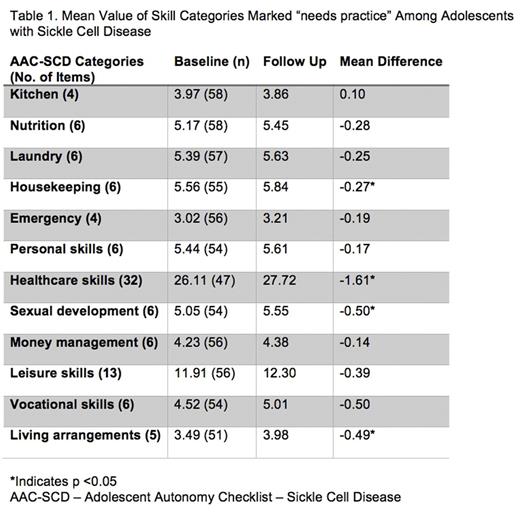Abstract
Background: The transition from the pediatric setting to adult care is a challenge for many adolescents with chronic disease. Patients with sickle cell disease (SCD) represent a unique cohort as the timing of psychosocial development of adolescence often coincides with worsening end organ damage. Previously, we used the Adolescent Autonomy Checklist (AAC) modified to include SCD specific tasks that patients with SCD need to practice in order to transition to adult healthcare and independent living. This study sought to use the AAC to measure the effects of skill based educational handouts on improving self-management and transition readiness in adolescents with SCD.
Methods: This was a single center, retrospective study approved by the Washington University Institutional Review Board. Inclusion criteria were patients with SCD, age 13-21 years, and completion of pre and post assessments. As standard care, patients from a pediatric hematology clinic completed the AAC-SCD. The AAC-SCD assesses skill level in twelve domains (Table). The tool includes 100 items, and users check "can do already" or "needs practice" for each item. After review with the coordinator, participants were given skill-based handouts based on up to five noted deficits. Patients completed the AAC-SCD at the subsequent clinic visit. In addition to baseline and follow up AAC-SCD data, medical and demographic data were collected via chart abstraction. All data were entered into SPSS for statistical analysis, including descriptives, paired sample T-tests, and bivariate Pearson's correlations.
Results: A total of 61 patients completed baseline and follow up. Of those participants, 49.2% were female. The mean age was 15.4 (+ 2.2) years. The genotypic distribution was as follows: 67.2% HbSS, 19.7% HbSC, 3.3% HbS-beta-thal+ and 9.8% HbS-beta-thal0. The majority of patients received healthcare coverage via Medicaid (52.5%), private insurance (45.6%) and 1.6% had no insurance coverage. Twenty-five patients (42.0 %) had a history of stroke or silent cerebral infarct and 34 (55.7%) were currently taking or were previously prescribed hydroxyurea. Formal academic support (IEP or 504 Plan) was reported for 20 (32.8%) of patients. At baseline, patients needed the most help with skills in the kitchen, housekeeping, personal care and leisure. Statistically significant improvements (p< 0.05) occurred in skills related to laundry, housekeeping, healthcare, sexual development and living arrangements. Modest sized and statistically significant correlation between the receipt of the educational handouts and decreased number of items marked "needs help" occurred in the areas of money management (r=-0.27, p=0.044), vocational skills (r=-0.27, p=0.046;) and laundry (r=0.32, p=0.015). A post hoc analysis by age groups 13-15 (n= 34),16-18 (n=24) and 19-21 (n=3) showed a decreased amount of items marked "needs help" in the areas of sexual development for both 13-15 year olds (r=0.42, p=0.024) and 16-18 year olds (r=0.93, p=0.001) as well.
Conclusion: Transition skills improved over time among adolescents with SCD. While we cannot say for certain if gains in knowledge occur with age as development progresses or if a formal transition program can be credited, providing educational materials on transition related skills within a clinic setting was associated with significant improvements in three of the domains. Our preliminary data offers insight into what skill deficits may be most amenable to educational interventions based on age group. As is the case with medical management, the development of a multimodal intervention is needed to prepare adolescents with SCD to transition to adult care and independent living. Clinic based education is a simple intervention that could be one component of future approaches to transition.
No relevant conflicts of interest to declare.
Author notes
Asterisk with author names denotes non-ASH members.


